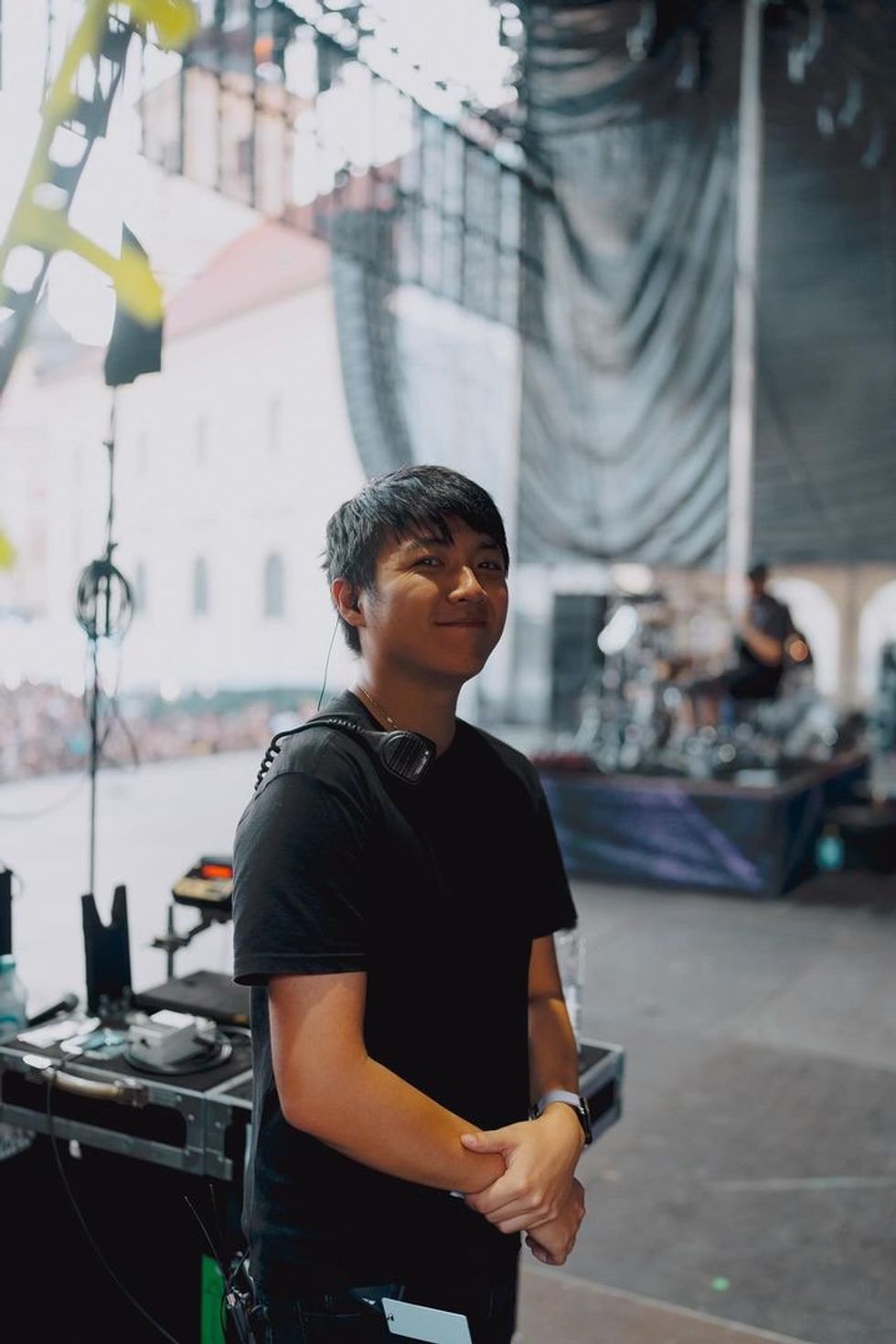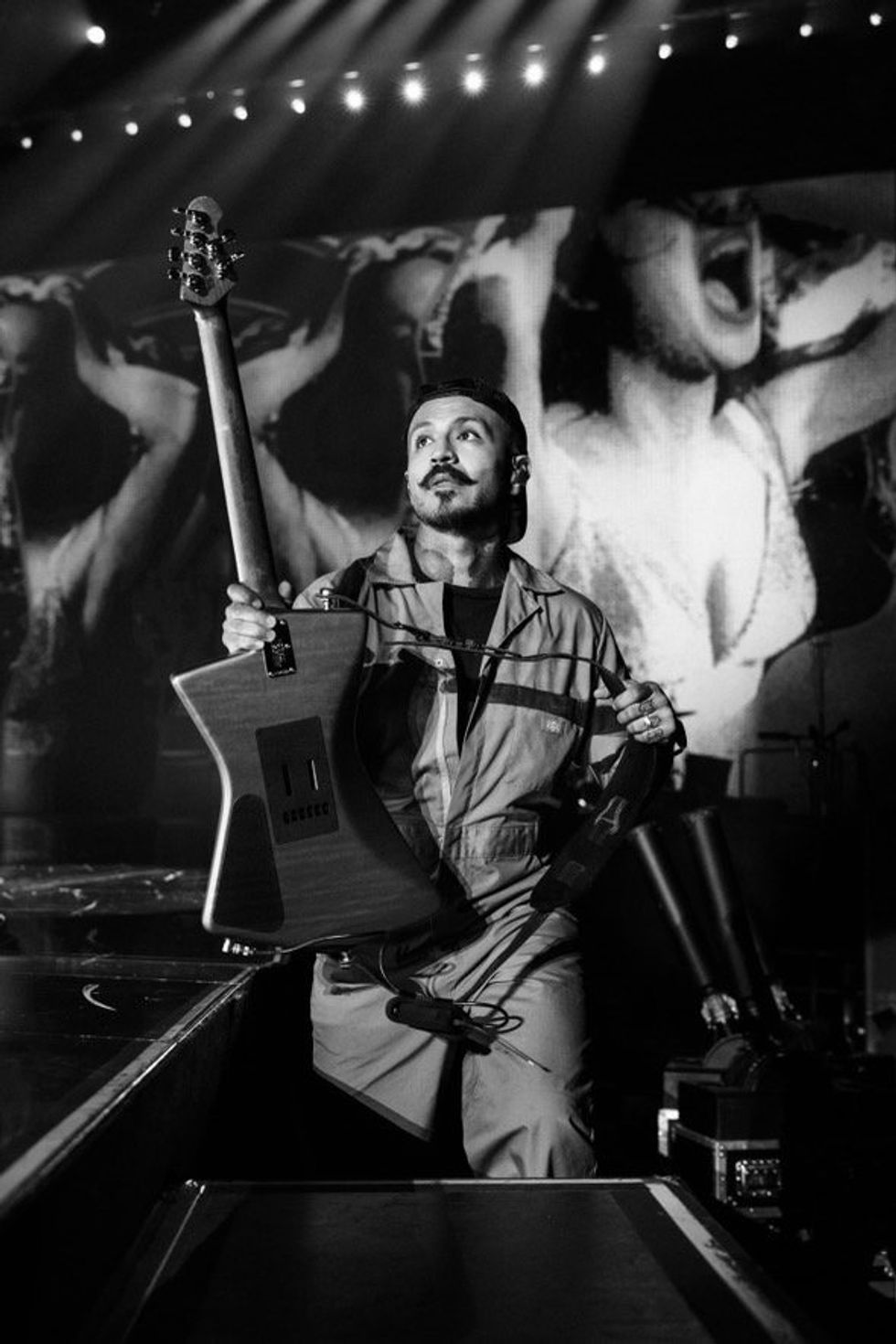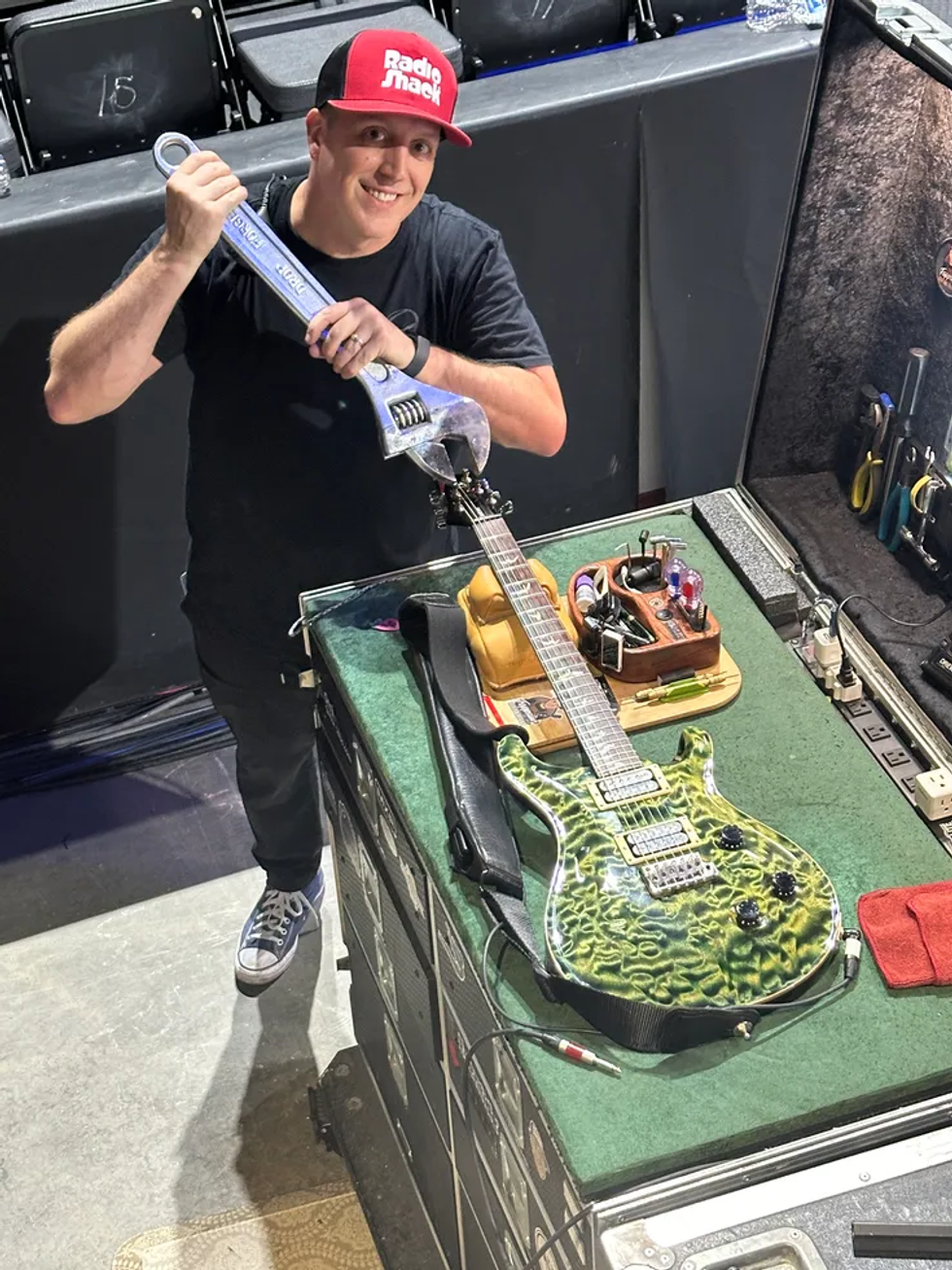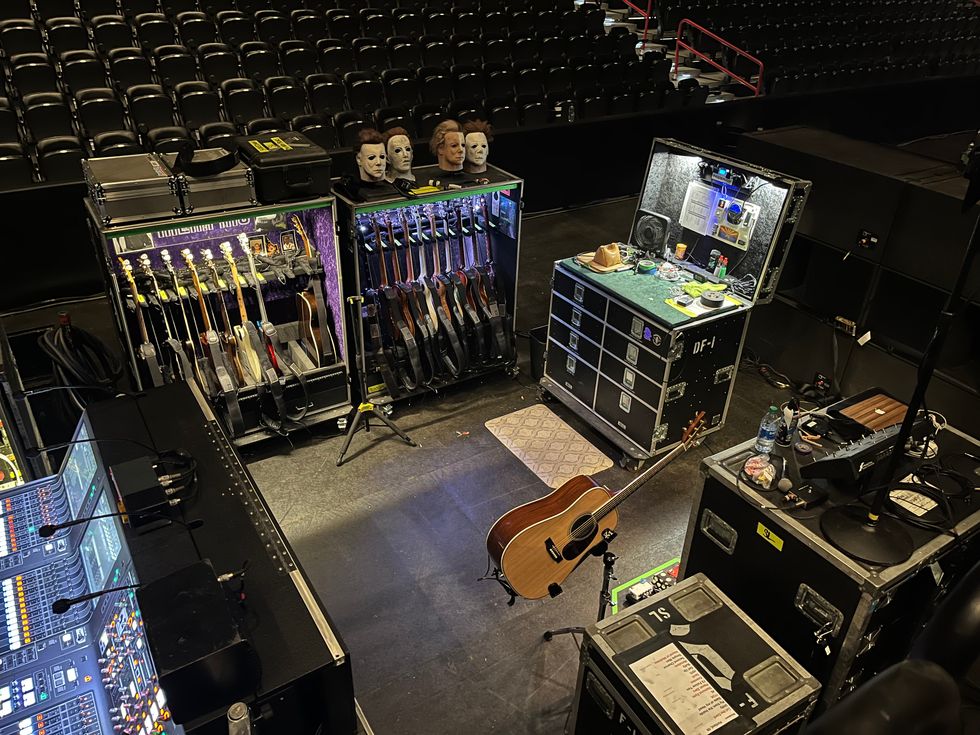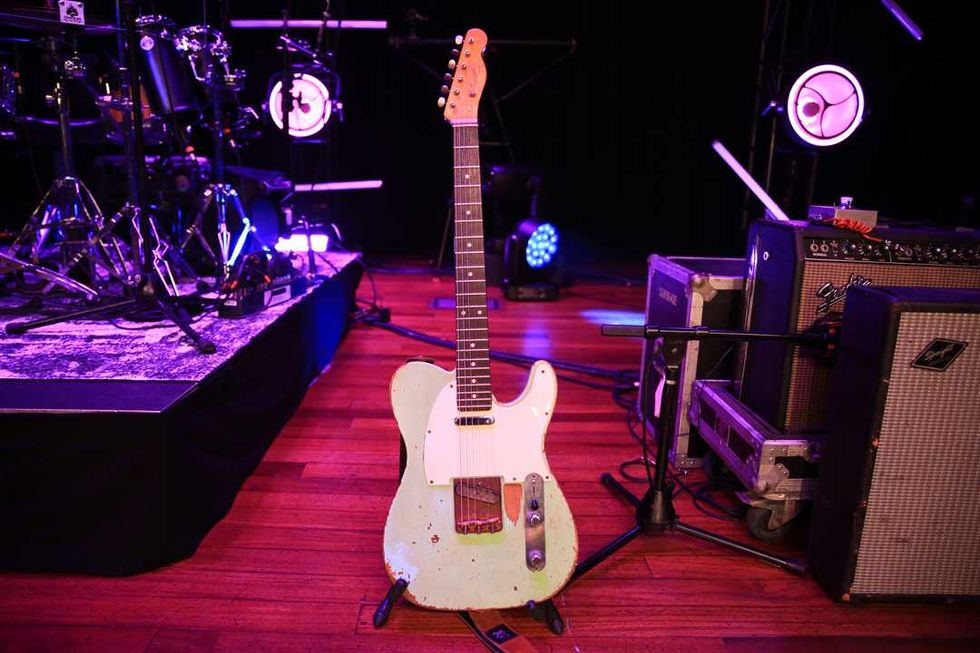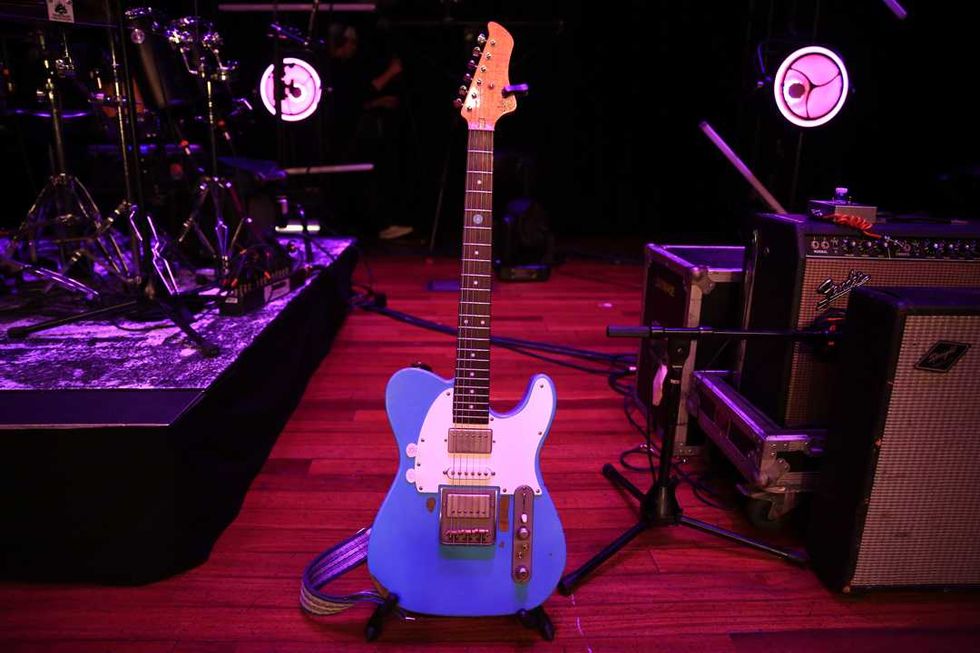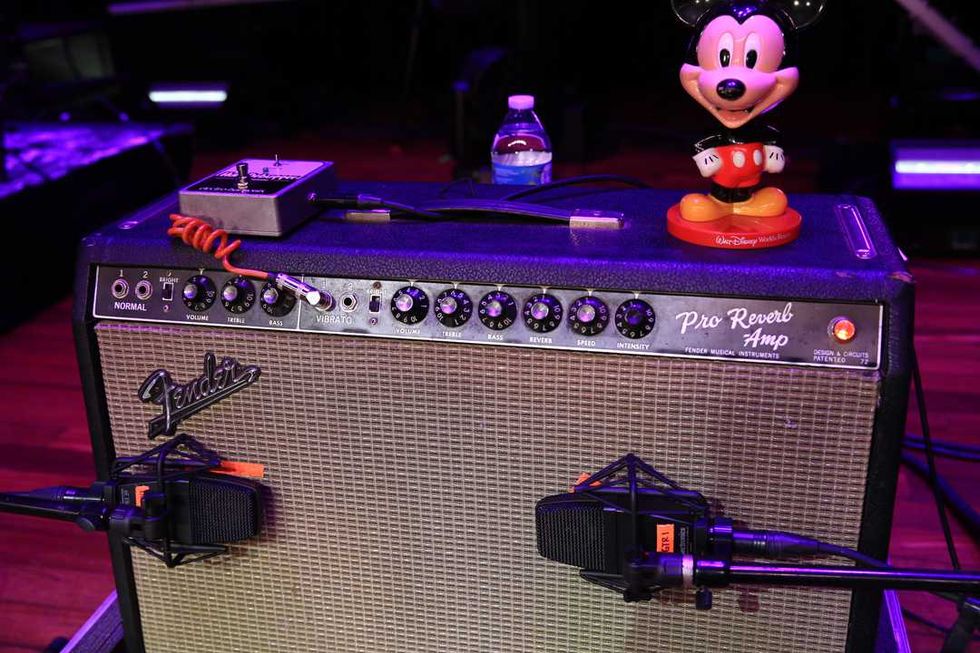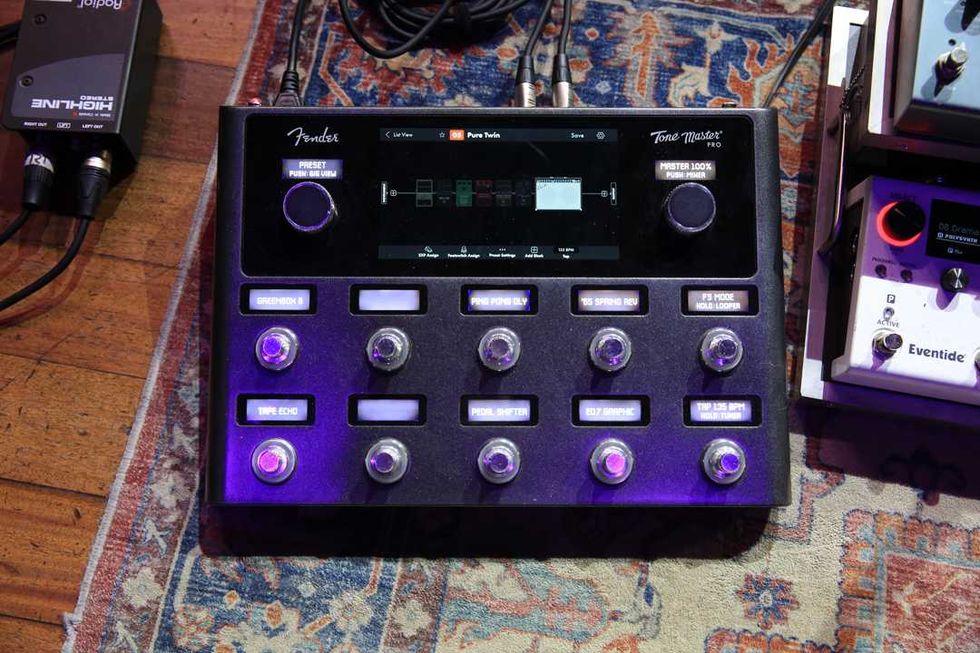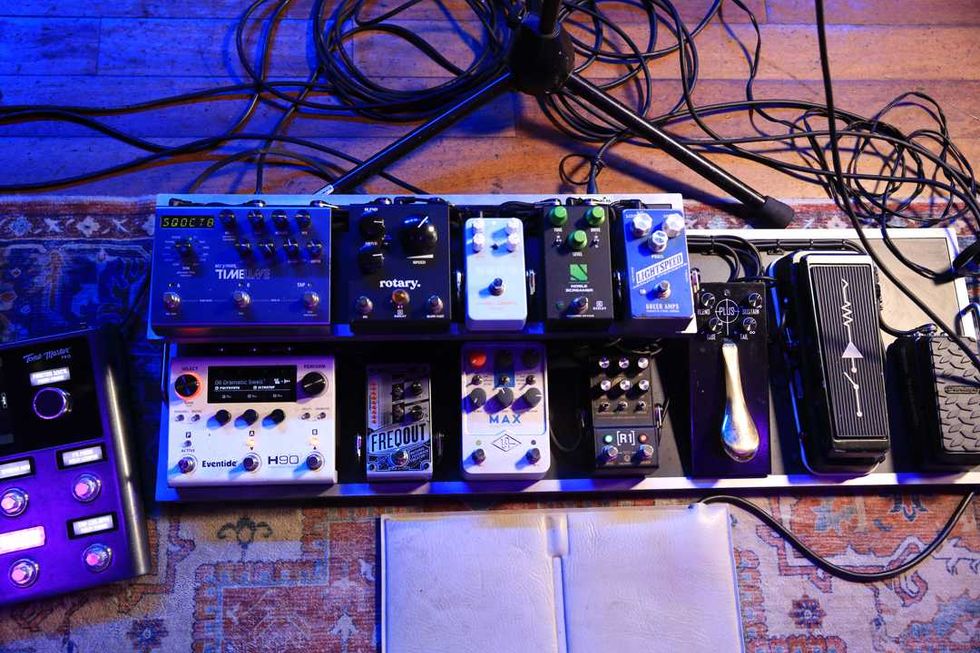The chemistry of a working band is a delicate thing. Working through the balance of personalities, egos, and experience can sometimes become as complicated as covalent bonds. However, replacing an original member of a band isn’t always a recipe for disaster. From the Sam and Dave drama of Van Halen to the revolving lead guitar chair in Megadeth, many bands have gone on to success after altering some of their band’s original DNA.
DragonForce had dealt with band members coming and going before but when it was announced in March of 2010 that original vocalist ZP Theart would be leaving the band, it created some uncertainty among their fans. After all, ZP had been the voice of the band on every album and in turn created some big shoes to fill. Founding guitarists Herman Li and Sam Totman, along with the rest of the band, decided to take a different route when it came to choosing the next singer for the band. “In a way, we had the whole world to choose from. When we were starting out, we didn’t really have much. There wasn’t much internet [access] at all and there definitely wasn’t any YouTube,” Totman notes. Thanks to those technological advances, the band encouraged anyone who was interested to send in an audition video.
After sorting through the piles of entrants, one singer stood out. Enter Marc Hudson, a 23-year-old guitaristturned- vocalist who impressed the band with his expressive and melodic style. After nearly a year of working with Hudson, the band announced in March of 2011 that they had found the new voice of DragonForce. PG caught up with Li and Totman to discuss life with a new singer, 30-fret guitars, and the story behind the group’s most diverse album yet, The Power Within.
Take me back to when the cycle for this
album started. Was ZP’s departure a surprise
or did you see it coming?
Totman: It was something that just sort of
panned out. I guess you could say we saw it
coming. We knew it was going to happen
before we started the album, and had a plan
together for that since we were going to be
working with someone else. I was still writing
songs and once we found the singer that
we wanted, it was just a matter of putting
it in the right key for his voice. Once we
found Marc, it took quite a while to learn
what parts sound good and what his range
is. It’s been quite a learning process to get
the best out of him, but I think we got it.
Li: I think musically we grew apart. For me, it was more like the band naturally moved that way.
Once it was announced that ZP was leaving,
you made the auditions open to the
public. Why did you choose that route
over a more private audition process?
Li: For this kind of music it’s not just a
“rah, rah, rah” type of singing. It’s quite
hard to find vocalists in this style and we
thought the only way we could find the
right one is to do a worldwide search. In
addition to people sending in their videos,
we also approached professional singers in
this genre at the same time.
Totman: I just thought it was a really cool idea. We could basically choose from the whole world since we were quite established now. It wouldn’t have mattered if they lived in a different country because you can always make albums by sending files around. When we found Marc, we knew that he was the best out there since we had so many people to choose from.
How long did this whole process take?
Li: It took a long time. In terms of Marc,
he sent in the video and we liked it and we
asked him to sing a few more songs. One
was “The Last Journey Home,” from the
last album [Ultra Beatdown], then “Fury of
the Storm” from Sonic Firestorm, which is a
really fast song with lots of words. We then
met up with him just to see his personality
and if we would be able to work with him.
After that, we moved on to rehearsing with
him and trying out new songs before moving
onto the recording studio to record new
songs and see how his attitude works in the
studio environment. All of that took almost
a year before we confirmed him to be a
band member.
Was a lot of the material written before
Marc joined?
Totman: Yeah, it was. I wrote and demo’d
some songs on my own and since it didn’t
have any singing on it, I played the vocal
parts on guitar. I just didn’t know what
key to put them in. Once we got Marc, I
changed a few vocal lines.
Li: A lot of the songs were written, but because we had a new singer we had to integrate him and find the energy again together as a band. In the old days, we would just write the song and go straight into the recording studio, stare at the computer, record it, and then go on tour. This time we had to jam and rehearse the songs again with Marc to create the energy.
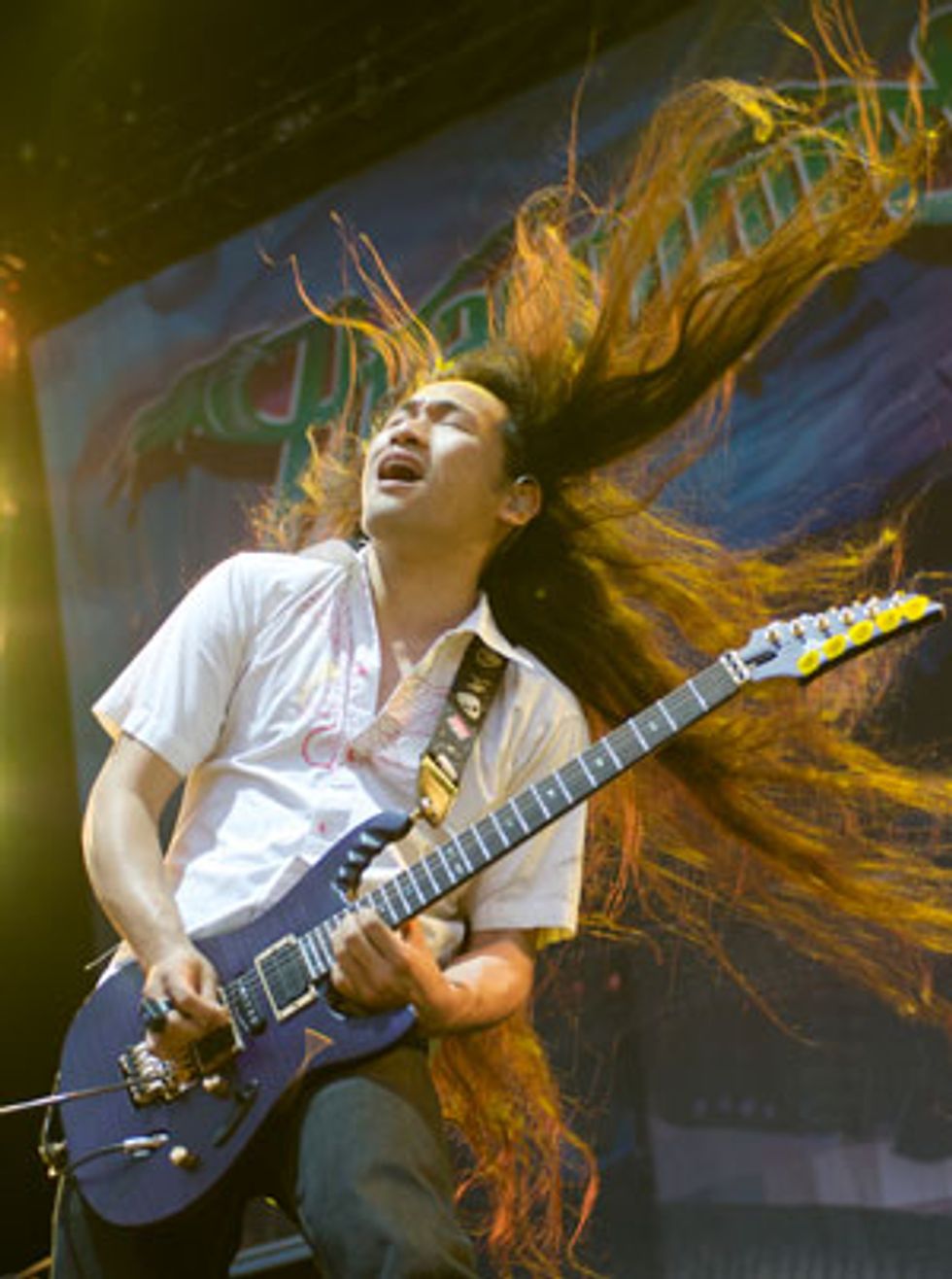
Herman Li—shown here with his signature EGEN Ibanez guitar and a particularly strong wind fan—took an improvisational approach when recording his solos for the new DragonForce record. Photo by Scott Uchida
Sam, what is your typical writing process?
Totman: I have a mini Pro Tools setup on my
laptop and I just program the drums with a
drum machine. Then I play the basic chords
and vocal lines, just a simple version of everything,
basically. Once the structure is done I
will give it to everyone else and have them put
their touches on it as well. I might do a drumbeat
but I wouldn’t put fills in all over the
place. I will just give it to Dave [Mackintosh,
DragonForce drummer] and he can work out
what fills he wants to do. Even though they
are simpler versions of the songs, it’s still quite
complete without the extra touches. This
time, once we got to the point where everyone
had demos, we did actually jam on them quite
a lot, which is something we don’t usually do.
That was cool. We got these little bits and
pieces that came out of that.
Did the extended break since the last
album reinvigorate the band and allow
you to experiment more?
Li: I guess we had more time actually playing
the songs and jamming them out rather
than going straight into the studio and
recording without playing together. This
time we really played the songs before the
album was finished. It gave us the time,
but we had to do it. It was really important
because we had a new singer. We couldn’t
just throw him into the studio and give
him a song and tell him, “See ya on tour.”
We needed to make Marc feel at home by
playing together and getting to know each
other’s personality. It’s almost like a social
event as well, just playing the music and
exploring his voice. By doing that, and
some shows before the album comes
out, we aren’t throwing him into this big
world tour that he has no experience in.
How did you want this album to sound
and stand out from your past records?
Totman: I thought, for a start, the songs
would be shorter. In the past, most songs
would be around seven or eight minutes.
Now they are all averaging about five
or so. That is something I wanted to do
anyway, whether we changed singers or
not. People don’t have the attention span
to get into something. It’s sad in a way
but I have become that way myself, too.
I can’t really bother listening to an eightminute
song either. I would rather hear
two catchy shorter songs. But to make
up for that, I tried to get everything
into that five minutes, so we aren’t really
losing something. We have more guitar
solos underneath vocals and compacted
it in a way without losing anything.
We also went back to more of a metal album sound. With the last couple of albums we had more electronic-y stuff and keyboards coming in, which I think was definitely cool at the time. But we realized that we took it as far as it could go. You could say the sound has gone back to more like what’s on Sonic Firestorm—before we started to bring all those extra things in with the keyboards— in a way. With Marc’s voice, we have more range to work with. I thought ZP had a great voice, but he wasn’t really good down low and Marc has a really nice tone when he sings down low and then he can sing really, really high as well. So it just gives us more room to make things interesting, really.
Did you have to change any of the
older songs to fit Marc’s voice?
Li: In a way, we are able to play the old
songs like we used to play them. I don’t
mean that in a bad way, but on the last
few tours we tuned down a half-step since
they were long tours and we didn’t want
to stretch our singer too much. Now, we
just play everything in standard tuning.
Totman: That was something that we had to take into account when choosing a singer. Obviously, when you write songs for a singer it suits them better because it fits them perfectly. We needed to get someone who could sing the old ones, so we tried them out and he sings them all really well. It never bothered me when bands would tune down like that but a few people would say, “Ah, they are down tuning, the singer must not be any good.” It’s funny, to say we are back to standard tuning now, but there you go.
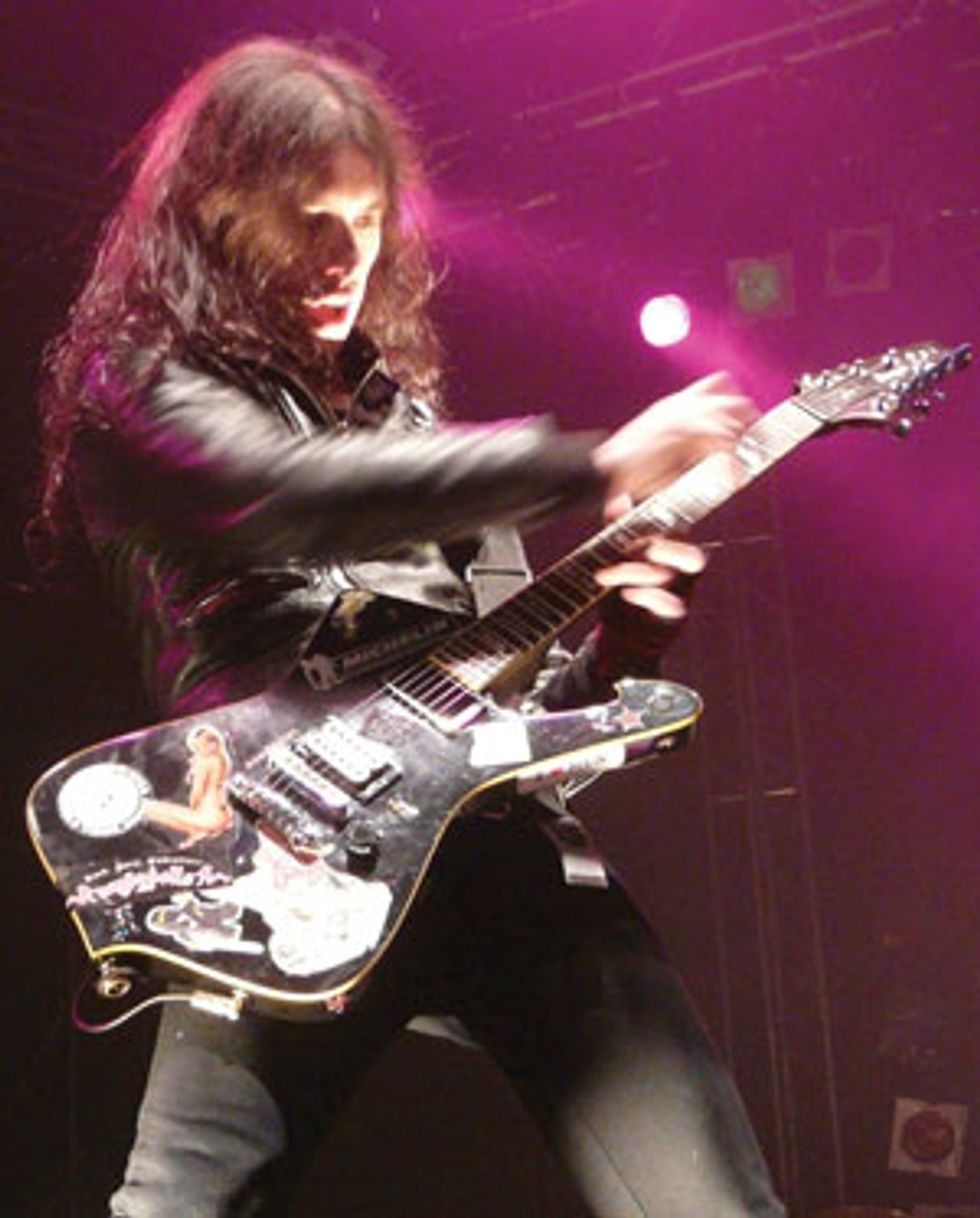
Sam Totman works his well-worn Ibanez STM2 signature model in London on June 17, 2011. Photo by Jukka O. Kauppinen
How do you split up the leads on an album?
Totman: We sort of just sit down and try
and make it “fair,” in a way. I will write the
solo sections out with the chord progressions
and then we will sit there and look at
what we’ve got and just try and make it balance
out evenly. If I am doing the second
solo on one song and there is another song
with the same kind of tempo, then he will
do that one. Rather than me always getting
the first one or vice versa.
Are your solos improvised in the studio
or written out ahead of time?
Totman: For me, I totally write them
all out because it takes ages to try not to
repeat any licks that you have used 100
times before. Every album gets harder and
harder. I will split it up with one bar of
something fast and then maybe a melody
thing for a few bars—something that people
can remember. From there, I might do
a funny noise or some technique. It’s really
a bar-by-bar process. The next step is to go
back and learn the whole thing and see if
it sounds good together. I think Herman
improvises them over the actual album
and then takes whatever one sounds best.
He might play five in a row or five takes
of one solo and then pick out the bits he
likes. I think he writes his solos quite a lot
faster than me.
Li: For my solos I took a standing-up, improvising approach where I don’t even look at the computer. If it sounds good, it’s good enough for me. In the old days I was obsessed with looking at the screen and seeing if I played it right or not. We try to approach it in a more organic way.
Do you stick to the same solos from the
album when you perform live?
Totman: I pretty much stick to mine how
they are. I think it’s cool when I go see a
band, or see a band’s DVD when I was
younger, and notice how they changed it
a little bit. I would never want them to
change it completely.
Li: The songs “Cry Thunder” and “Fallen World” changed. After playing it live, I ended up doing a different solo on the album.
Was there a solo on the new album that
was particularly challenging?
Li: It varied from song to song. For example,
“Give Me the Night” was either the
first or second take. We just went straight
for it. Some songs took a long time, like
I did the solo two months before and I
would revisit it and end up changing it.
Even though you mentioned you wanted
to stay away from longer songs, “Wings
of Liberty” sounds like a return to your
earlier sound.
Totman: That’s what I call a more typical
DragonForce song. That was the nightmare
of the whole album for me. I just couldn’t
get it together at all. For probably over a
year I couldn’t get a middle section. I considered
getting rid of it the whole time. This
Pro Tools session I have for the demo was
about 15 minutes long with all the different
bits. I would put some in and then take
them out and try new things. I went over to
Fred’s [Frédéric Leclercq, DragonForce bassist]
and asked him to please try and write
a middle section for this song. There are so
many bits and pieces to it—I guess that’s
why it came out the length it did.
DragonForce is known for playing at
insanely fast tempos, but “Cry Thunder”
shows a different side of the band.
Li: In the old days we said we were never
going to do a mid-tempo song. Guess what?
Here is a mid-tempo song. We play a lot
of fast solos and songs over that 200 bpm
beat, so let’s see if we can pull the tempo
down and see if we can express music differently.
It forces us to evolve because when
you play fast all the time you might start to
play a lot of the same licks and ideas.
Totman: The first thing I think of when I am writing a song is what drum beat it’s going to have. I thought okay, I will do a song that has a 6/8 [sings beat], or whatever the technical word for that beat is. Then it has that Irish-sounding melody. I have always thought Irish music was quite cool with that folky kind of sound. I think it came together more easily because I had written so many songs at that same 200 bpm tempo, it was hard to think of something new. I had never written anything at that [slower] speed before, and it came out quite easily.
On the other side of the dial, so to speak,
we have “Fallen World.” Is that the fastest
tune DragonForce has recorded?
Totman: Yeah, I think it is. “Cry of the
Brave,” which was a bonus track on Sonic
Firestorm, is pretty fast. I thought “Fallen
World” was the same speed, but apparently
it’s about 5 bpm faster, so it’s not a huge
leap. Basically, 90 percent of our fast songs
are all about 200 bpm, so we thought we
should do one at 220. The first thing I
thought was to put the metronome at 220
and see what happens. That’s another example
of how the speed determines the song. I
found that anything much over 200 didn’t
really suit it. I know with all these thrash
bands that I used to listen to like Sepultura
and Slayer, their fast songs might be at like
240 or even 250, and I tried writing some
stuff for us at that speed and it didn’t really
work, but 220 seemed to be okay. Then
again, what’s fast? People would say, “Wow,
you play really fast,” but the vocals aren’t
particularly fast. Just because the drums are
fast, you can still ring out some chords.
Li: Because we were writing some midtempo songs like “Seasons,” and even “Die By the Sword,” which is a bit slower, we thought we had to push the other way as well. We pushed it faster and put the 7-string guitars on it and kept it heavy and brutal but still melodic and catchy. That was one of the ways we let the fans know we haven’t gone in a completely opposite direction here. We still have the classic, fast DragonForce songs like the opening to “Holding On” and “Heart of the Storm.”
Did you use 7-string guitars for the
rhythm part of that tune?
Totman: Yeah, we have always had them
here and there on albums. All of “Fallen
World” is on the 7-string, because that is the
way the key turned out. It panned out by
accident actually because it wasn’t supposed
to be on 7-string. Once we figured out what
key suited Marc’s voice, we kept finding we
were coming up on this low B chord.
Li: There is a section of “Cry Thunder” where we just bring the 7-string in really quickly, which I think is just before the solo kicked off just to add a little power. The heavy riff on “Give Me The Night” is on a 7-string.
How did you approach your guitar tones
for this album?
Li: We try to make the two guitars sound
slightly different so they complement each
other. One has a bit more low end and the
other backs off on that and maybe adds
more mids. Also the pickups are different.
On Sam’s guitar, he has a neck-through
body with DiMarzio Evolution pickups.
Herman Li's Gear
Guitars
Ibanez EGEN18 Herman Li signature model, 30-fret Ibanez RG2011SC
Limited Edition, custom Ibanez 7-string EGEN18 Herman Li signature
Amps
Mesa/Boogie Stereo 2:Fifty power amp, Peavey JSX 4x12
straight cab
Effects
Rocktron Prophesy 2, Digitech Whammy, Dunlop Cry Baby Wah Rack
Module DCR2SR, Roland GR-55, Boss ST-2 Power Stack, Boss CE-5 Chorus Ensemble,
Source Audio Hot Hand Wah and Hot Hand MIDI-EXP controller, Rocktron Hush Pro+,
Rocktron PatchMate Loop 8,
Strings, Picks, and Accessories
D’Addario EXL125 .009-.046 (.059 on
7-strings), Samson wireless system, MIDIjet PRO wireless MIDI, AKG IVM 4 in-ear
wireless monitoring system
Sam Totman's Gear
Guitars
Two Ibanez STM2 Sam Totman signature models (the blue one
contains DiMarzio D Activator pickups and the white one has DiMarzio Evolution pickups),
Ibanez RG7620
Amps
Mesa/Boogie Stereo 2:Fifty power amp, Peavey JSX 4x12
straight cab
Effects
Rocktron Prophesy 2
Strings, Picks, and Accessories
D’Addario EXL125 .009-.046 (.059 on
7-strings), Samson wireless system, MIDIjet PRO wireless MIDI, AKG IVM 4 in-ear
wireless monitoring system
What guitars did you use on the album?
Li: We used the usual Ibanez signature guitars,
the EGEN18 and Sam’s STM model.
He had two of them, the white one had the
DiMarzio Evolution pickups and I think
we put a pair of D Activator pickups on
the blue one. My guitars were pretty much
stock but we did add some 7-string guitars
on this album, so Ibanez made a 7-string
version of my signature model and Sam
used an Ibanez RG7620.
Is the 7-string model a prototype for an
upcoming model?
Li: No, I just got a custom one. No plans
to release a 7-string model at the moment.
Tell me about how you used the 30-fret
guitar on the album.
Totman: I used that quite a lot, in fact. I
would wind up doing some lead or something
and the way the key happened to
be, I wanted to get to a certain note and I
found that this guitar was very useful.
Li: It was mostly used to do the high harmonies. In the old days, we would do a part and then tune up the strings, but now with this 30-fret Ibanez RG it really helped us to try some things out. It worked great for some crazy high notes, tapping, and things like that. The last solo on “Fallen World” you can hear some of that and on “Heart of the Storm.”
What’s the most difficult part about playing
those fast tempos?
Totman: The rhythm guitar. You might do
a lick in a solo on a ballad and it’s just as fast
as something you might play in a fast song.
Those fast songs, especially “Fallen World,” it
was just doing the rhythm with the backwards
and forwards picking at that speed. That was
on 7-string guitar as well, which is quite hard
to get the sound clean without it turning into
a mess. I couldn’t do that straight away. In
fact, we have to put in the middle of the set,
because I need warming up for that, definitely.
Do you guys take different approaches to
your pre-gig warm-ups?
Li: These days I do a one-hour warm-up before
the show, but not by playing fast because then
my hands would be tired. I just relax and play
through my little Boss BR-80. It has all the
songs pre-loaded and I just plug my guitar and
in-ear monitors right into it and play along. I
do that for about an hour and then just unplug
my monitors into my stage pack and there we
go. Even when there are people around drinking,
I can carry around and practice.
Totman: Yeah, I just sit there and practice a bit, I suppose. I don’t do a lot of warming up. The way I see it is you aren’t going to have to play a lead until halfway through the first song, so by the time I get to the first lead I am warmed up because I have been playing rhythm for a few minutes. I pretty much don’t bother.
Youtube It
Watch Herman Li and Sam Totman
deliver their futuristic
brand of shred to the masses.
While opening for Iron Maiden in Belfast, new vocalist Marc
Hudson tackles one of the most challenging DragonForce songs.
“Fury of the Storm,” one of the band’s most popular songs, is
full of “over the top” guitar pyrotechnics by both Li, who abuses
the whammy bar on his Ibanez, and Totman, who is seen here
playing a Jackson V. Don’t miss the section at 0:36.
DragonForce plays some new material while introducing their
new singer on a short promotional tour. Armed with their signature
Ibanez guitars, Li and Totman play Celtic-inspired dual
leads at 2:29.






![Rig Rundown: AFI [2025]](https://www.premierguitar.com/media-library/youtube.jpg?id=62064741&width=1245&height=700&quality=70&coordinates=0%2C0%2C0%2C0)












 Shop Scott's Rig
Shop Scott's Rig










![Devon Eisenbarger [Katy Perry] Rig Rundown](https://www.premierguitar.com/media-library/youtube.jpg?id=61774583&width=1245&height=700&quality=70&coordinates=0%2C0%2C0%2C0)








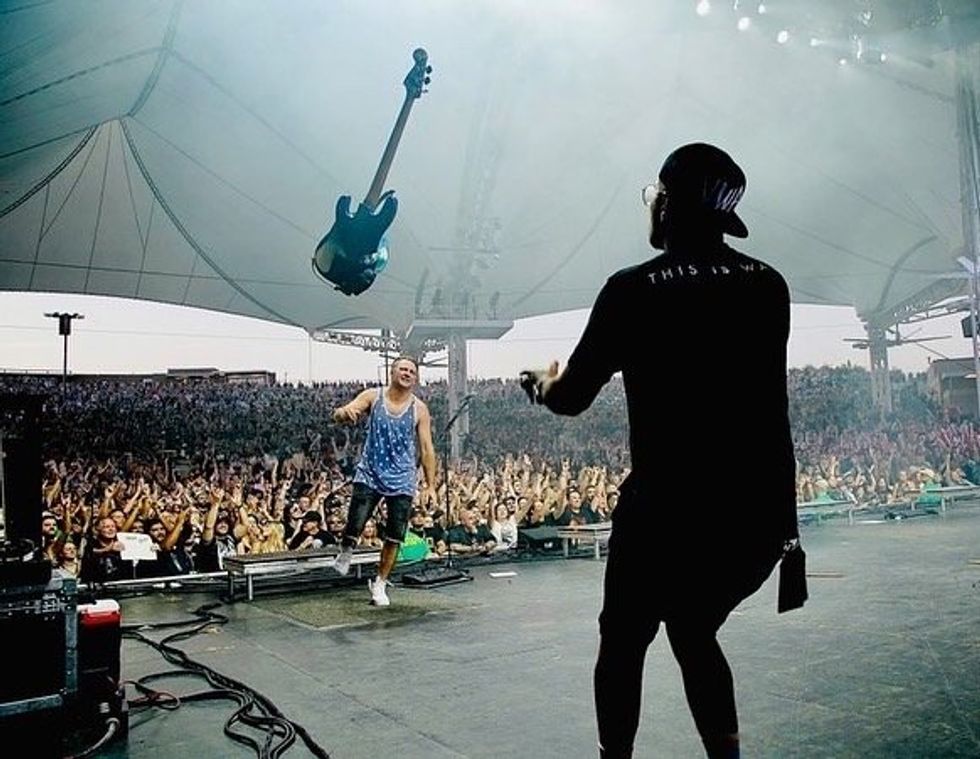 Luis Munoz makes the catch.
Luis Munoz makes the catch.